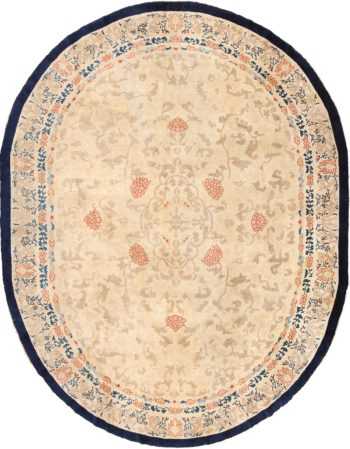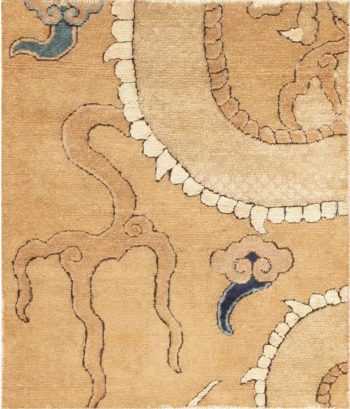Chinese Cloud Band Design Rugs
Explore some of our favorite Chinese cloud band design rugs:
Antique Cloud Band Design Oval Chinese Dragon Rug 49592
$16,900.00Size: 9 ft x 11 ft 7 in (2.74 m x 3.53 m)Antique Cloud Band Dragon Design Chinese Pillar Rug 71794
$8,800.00Size: 4 ft 4 in x 6 ft 10 in (1.32 m x 2.08 m)Antique 16th Century Ming Dynasty Dragon Chinese Fragment 47381
$19,000.00Size: 3 ft x 3 ft (0.91 m x 0.91 m)
The Heavenly Chinese Cloud Band Design In Rugs
History of the cloud band pattern
The cloud band is a motif that is found in many Oriental rugs throughout many areas of the world. Its sinewy, undulating form encourages you to drift along with the clouds as you float along on a warm afternoon. This motif appears as a curvy shape with representations of billowy clouds along its line. The curvy lines create a feeling of movement in the piece. The cloud band design rugs have a sublime quality that deserves to be explored further.

17th Century Cloud Band Antique Chinese Ningxia Runner
Cultural Blending Of the Cloud Band Design
The cloud band design is evidence that, although Chinese and other Oriental rugs developed locally identifiable characteristics, some cultural exchange took place in both directions. It is not uncommon to find Persian motifs in Chinese rugs, and one can often find the classic cartouche or floral elements that are distinctively Persian in origin in Chinese carpets. The cloud band design is evidence that this exchange went in both directions. The cloud band design was initially found in Chinese art and later worked its way into the designs of the formal Persian carpet weaving schools.
The migration and introduction of this design say more about the trade routes, particularly the routes that collectively were known as the Silk Road, and their importance in the exchange of ideas and technology. It is possible to trace these connections and the effects that they had in transforming societies using motifs found in artwork. In this way, the cloud band design is an important tool for understanding these exchanges.
This understanding goes beyond an artist encountering a design, committing it to memory and then taking it home to use in their own work. The transmission of these symbols often represents the conveyance of the meanings that go along with them too. The spread of this fascinating motif represents the exchange of cultural and religious ideas throughout the area.
Origins and Spread Of The Chinese Cloud Band Design
The first use of the cloud band appears in the Han dynasty (206 BCE-220 CE). After this time, it appears in great abundance throughout all forms of Chinese art and art throughout the rest of the world. The appearance of the cloud band motif seems to emerge about the same time as the cloud collar on Chinese clothing. The Han Dynasty wanted to establish itself as rulers of divine choice. The cloud collar represents the opening to the gates of heavenly realms. The cloud band design also has a connotation that has a connection with the heavenly realms.
The Chinese believed the opening to heaven is located in the night sky centered around the pole star. In Chinese architecture, this point is often represented by the top of the ceiling. It is also the center of the cloud collar. One will often find the cloud band motif arranged in a circular or square form around a center. It is commonly found in Persian rugs around the medallion in the center. All of these renditions highlight its significance as a symbol for the opening to the heavenly realms.
The design appeared in the court carpets of Shah Abbas and continued to be featured in Persian rugs until around the end of the 18th century, but you can still find some rugs produced after that that use this design. It is especially prevalent throughout carpets of the 16th century and is found in some of the most beautiful Turkish Court carpets as well.
The Chinese Dynasties were established as centers of architecture, art, and technology long before the establishment of the Persian and Ottoman empires. However, contact between these cultures can be traced to at least the 13th century as merchants exchanged goods. It is not known exactly when the cloud band design began to appear in Persian art, but it seems to be sometime after the Mongol invasion and the Timur rulers. Scholars have suggested that the adoption of the cloud band design, and other Chinese motifs such as the Lotus, dragon and Phoenix in Persian art, was an attempt to emulate the wealth and prominence of the Chinese empire. Interestingly, the Persian clothing began to feature the cloud collar at around the same time.
Prevalence and Use of Cloud Band Design
The cloud band can be prominent and easily recognizable, or it can be found transformed into undulating leaves and floral patterns. Throughout its travels across the world from its origins in China, it has been transformed into many different shapes. Sometimes it will appear as zigzags, wavy lines or serpents. Sometimes it is stylized in such a way that resembles the Greek letter Omega.
The pattern is prominent in its original form throughout China. It is also prominent in Persian, Armenian, and tribal rugs of the Caucasus Mountains. As it traveled throughout the region, this design took on the characteristics of the other motifs in the area. In Persian carpets, it can appear as leaves, vines, or a ribbon that works its way throughout the design. In Armenian and tribal rugs, it often takes on a more angular, geometric characteristic.
The cloud band design appears in many different forms throughout carpets of Asia and the Middle East. It has ancient origins and an association with a connection to the heavenly realms. It seems that this meaning changed little throughout its spread. One cannot help but think of the sublime meaning behind the cloud forms. This motif is a beautiful addition to carpet design, and some of the most captivating carpets are based on it.
Feel free to browse our collection of cloud band carpets from many areas of the world. These carpets add a lofty feel to the room and are the perfect piece for traditional, oriental and contemporary designs. These magnificent carpets are both beautiful and highly collectible. Our collection of available cloud band carpets changes often, so be sure to check back regularly to see what we have in for you



